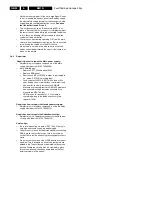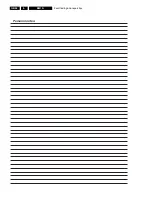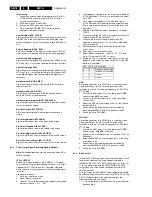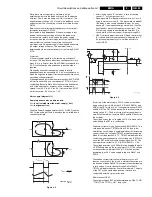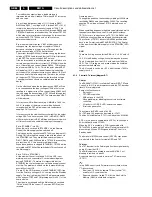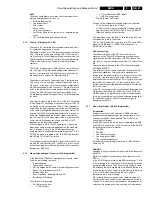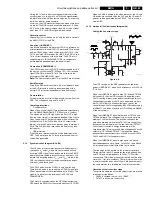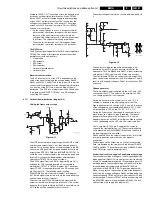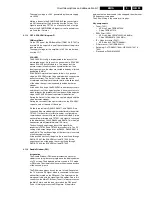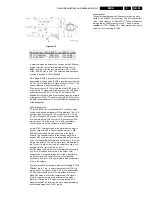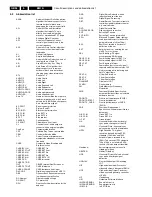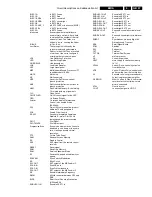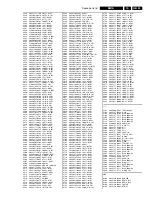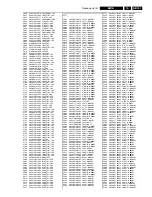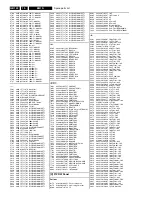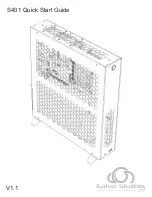
Circuit descriptions and abbreviation list
GB 87
EM1A
9.
NVM
The Non Volatile Memory contains all set related data that
must be kept permanently, such as:
•
Software identification.
•
Operational hours.
•
Error-codes.
•
Option codes.
•
All factory alignments.
•
Last Status items for the cu a complete factory
recall.
•
TXT featuring (keeping habit watch data).
9.1.5
Tuner & IF (diagram A7 & B2)
The tuner is I2C-controlled and is capable of receiving off-air,
S- (cable) and Hyperband channels:
The tuning is done via I2C. The reference voltage on pin 9 is
33 V. This voltage is derived from the 180 V (from the LOT)
via 2 resistors of 120 k
Ω
(diagram F) and a zenerdiode. The
Painter together with the HIP controls the tuning procedure.
There is also automatic switching for the different video
systems.
The IF-filter is integrated in a SAW (Surface Acoustic Wave)
filter. The type of this filter is depending of the standard(s)
that has to be received. Two SAW filters are used: One for
filtering picture-IF and one for filtering sound-IF.
The output of the tuner is controlled via an IF-amplifier with
AGC-control. This is a voltage feedback from pin 62 of the
HIP to pin 1 of the tuner. AGC take-over point is adjusted via
the service alignment mode ’Tuner AGC’. If there is too much
noise in the picture, then it could be that the AGC setting is
wrong. The AGC-setting could also be mis-aligned if the
picture deforms with perfect signal. The IF-amplifier amplifies
too much.
The video IF-signal is fed to pins 2 & 3 of the PLL-controlled
IF-demodulator. The voltage controlled oscillator of the PLL
is adjusted via the service menu ‘IF AFC’. If the alignment is
correct then the displayed frequency in the installation menu
is the same as the applied frequency from a generator. The
external coil L5408 connected between pins 7 & 8 is used as
reference. The demodulated IF-video signal is available at
pin 10 of the HIP. In this video signal there is a rest of sound
carrier, which is filtered by the sound trap 1406 or 1407
(depends on the received standard).
Then the signal is fed to the HIP again (pin 12) where the
group delay can be corrected, dependent on the standard
that is received. On pin 13 the CVBS-signal becomes
available which is used for further processing in the TV. Via
TS7322 the signal is supplied to AV1 (PIP/DW) and back into
the HIP (pin 14) to the I/O selection.
To realise quasi split sound, the IF-signal is fed to the HIP on
pin 63 & 64 via SAW-filter 1405. The FM (or AM for L-norm)
-modulated signal is available on pin 5 and is fed to the audio
demodulator MSP34xx.
9.1.6
Video: High-end Input Processor (HIP, diagram B2)
In the EM1A the TDA932xH input processor is used, which
contains the following functions:
•
IF demodulation.
•
Group delay correction.
•
AFC signal generation, used to track drifting transmitters.
•
Sound carrier re-generation (SIF).
•
AM demodulation.
•
Sync acquisition, delivering HA and VA.
•
Switching off IF-filtering.
The HIP has various inputs.
•
Full matrix switch with:
–
2 CVBS inputs
–
2 Y/C (or additional CVBS) inputs
–
1 CVBS front end input
•
Two RGB and 1 YUV-input
Outputs: Three separate switchable outputs can be used:
•
1 YUV-output is fed to the PICNIC
•
2 CVBS outputs: One for Teletext Dual Screen and the
other for output to MONITOR OUT to have WYSIWYR
(What you see is what you record)
The input signals from the Front I/O are fed to the HIP and
front detection is fed to the Painter.
AV1 is a CVBS- and a YUV input (e.g. for DVD), while AV2 is
meant for CVBS and Y/C (SVHS). The 3rd option is a
MONITOR OUT-output.
Video processing
The sandcastle-pulse of the HIP will not be used for
synchronisation. The HOP will generate synchronisation
signal derived from the feature box (PICNIC) signals. The
HIP itself (no external voltage) controls the Y/C switch in the
HIP.
The chrominance decoder in the HIP is full multistandard:
PAL/SECAM/NTSC.
Two different crystals can be connected to the pins 54 & 57
without any alignment. The crystals are also used as a
reference for the synchronisation. A digital control circuit that
is locked to the reference signal of the colour decoder
determines the start-up of the sync. This crystal may only be
replaced by the original one. If just a crystal is taken, the
internal capacitance will be different and the effect will be that
there is no colour.
In the HIP, a sync separation circuit has been integrated; the
HIP delivers the HA and VA (50/60 Hz) to the PICNIC and
PIP/DW module. On pin 59 there is the 1fH sandcastle but
this is not connected to any circuit and only used internally for
the colour demodulator. The 2fH-sandcastle signal is
generated by the HOP.
9.1.7
Video: Feature box (PICNIC, diagram B3)
Introduction
The basic function of the Feature box (FBX6) is picture
improvement, and depending on the version several scan
conversion methods can be applied. The PICNIC is the
central key component.
In the EM1A-chassis the featurebox is integrated on the SSB.
The PICNIC is used for the 100 Hz conversion. In the PICNIC
the following functions are present:
•
The ADC.
•
The DAC.
•
The 100 Hz conversion.
•
The noise limiter (DNR).
•
The contrast improvement.
All these functions are integrated in one IC: SAA4978H, a
160 pins QFP
ADC/DAC
Analogue to Digital conversion is done with three identical 9-
bit ADC's.
Digital to Analogue conversion uses three identical 10-bit
DAC's.
In the PICNIC there are three 9 bits ADCs present for Y, U &
V. For digitising the Y (luminance) 9 bits are used, to realise
a more detailed picture. The 9 bits are only internally used.
Via dithering the 9 bits are reduced to 8 bits and that data is
stored into the memory. The data in the memory is fed back
to the PICNIC and via undithering the data is again
reproduced 9 bits for processing.
U/V (colour difference signals) is also sampled with 9 bits.
These two 9 bit data streams are multiplexed to 4 bits data
streams. This reduction can be allowed, as the perception for
colours by the human eye is less sensitive as for luminance.


